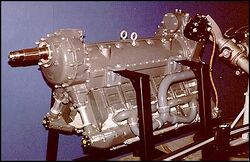Engineering:Ikarus 215
| Ikarus 215 | |
|---|---|
| Role | Trainer (aircraft)/Bomber aircraft |
| National origin | Yugoslavia |
| Manufacturer | Fabrika aero i hidroplana Ikarus A.D. Zemun - Belgrade |
| Designer | Eng. Dušan Stankov |
| First flight | 1949 |
| Introduction | prototype |
| Retired | 1957 |
| Status | inactive |
| Primary user | SFR Yugoslav Air Force |
| Number built | 1 |
The Ikarus 215 (Икарус 215 in Serbian) twin-engine plane, was a Yugoslav light bomber and a training aircraft of mixed construction, the prototype flew in 1949. It did not go into production. The prototype was used for training and as a liaison. It was designed and built at the Ikarus factory in Zemun-Belgrade.
Design and development
Ikarus 215 was designed by engineer constructor Dušan Stankov, and was originally designed before the World War II as a Zmaj R-1 multi-purpose fighter - bomber - but the scout redesigned given the available engines and purpose. The prototype first flew in 1949. It was a twin engined low-wing aircraft of mixed construction, with a crew of two to four (depending on the role). The undercarriage retracted into the engine nacelles backward, while the tail wheel was fixed. The prototype was driven by two twelve-cylinder, air-cooled, in-line piston engines Ranger SVG-770 C-B1.[1] Aircraft wing had a wooden structure lined with plywood, was the trapezoid-shaped wings and the ends were rounded. The construction of the fuselage was made from an oval-shaped duralumin covered cardboard timber.[2]
Operational history
Aircraft Ikarus 215 series are not produced. During testing it was determined that the aircraft will not be able to respond to the primary purpose (light twin-engine bomber), it has also contributed to the unexpectedly rapid development of aviation, fighter-bomber takes on the role of light bomber. Ikarus 215 prototype aircraft is mainly used as a training school for the training of bomber pilots as the plane for the connection. Withdrawn from use in 1957.[3]
Operators
 Yugoslavia
Yugoslavia
- Yugoslav Air Force 1 aircraft
Specifications
Data from :Janić, Čedomir. "Rogožarski AŽR" (in (Serbian)). Aeromagazin 17 (-{YU}--Београд: BB Soft), p 34. ISSN 1450-6068.
General characteristics
- Crew: 2-4
- Length: 13.35 m (43 ft 10 in)
- Wingspan: 16.14 m (52 ft 11 in)
- Height: 4.03 m (13 ft 3 in)
- Wing area: 29.80 m2 (320.8 sq ft)
- Empty weight: 3,424 kg (7,549 lb)
- Gross weight: 4,685 kg (10,329 lb)
- Powerplant: 2 × Ranger, SGV-770C-1(12-cylinder inverted Vee piston engine), 387.7 kW (519.9 hp) each
- Propellers: 2-bladed
Performance
- Maximum speed: 374 km/h (232 mph, 202 kn) at altitude of 3500 m and mass of 4297 kg
- Range: 1,120 km (700 mi, 600 nmi)
- Service ceiling: 8,150 m (26,740 ft)
Armament
- Guns: 3 × MG-15 with 225 rounds per gun
- Bombs: 4 × 50 kg
See also
- SFR Yugoslav Air Force
- Ranger V-770
- Zmaj R-1
- Dušan Stankov
Notes
- ↑ Gunston, Bill. World Encyclopedia of Aero Engines. Cambridge, England. Patrick Stephens Limited, 1989. ISBN:1-85260-163-9
- ↑ Златко Рендулић, Авиони домаће конструкције после Другог светског рата, Лола институт, Београд, 1996. год.
- ↑ Бојан Б. Димитријевић "Југословенско ратно ваздухопловство 1942.-1992."
References
- Grey, C.G. (1972). Jane's All the World's Aircraft 1938. London: David & Charles. ISBN 0-7153-5734-4.
- Gunston, Bill. World Encyclopedia of Aero Engines. Cambridge, England. Patrick Stephens Limited, 1989. ISBN:1-85260-163-9
- Janić, Čedomir; O. Petrović (2011). Short History of Aviation in Serbia. Beograd: Aerokomunikacije. ISBN 978-86-913973-2-6.
- Бојан Б. Димитријевић "Југословенско ратно ваздухопловство 1942.-1992."
- Жутић. Н. и Бошковић. Л., Икарус - Икарбус: 1923 - 1998,(Монографија 75 година Икаруса), Икарбус, Београд, 1999.
- Златко Рендулић, Авиони домаће конструкције после Другог светског рата, Лола институт, Београд, 1996. год.
External links
- http://vazduhoplovnetradicijesrbije.rs/index.php/istorija/247-ikarus-215
- www.aeroflight.co.uk/waf/yugo/af2/types/ikarus.htm
- www.dragan.freeservers.com
 |


